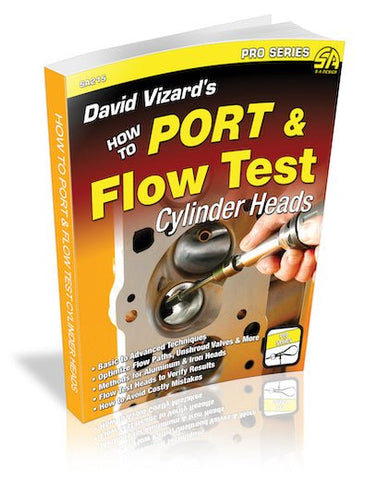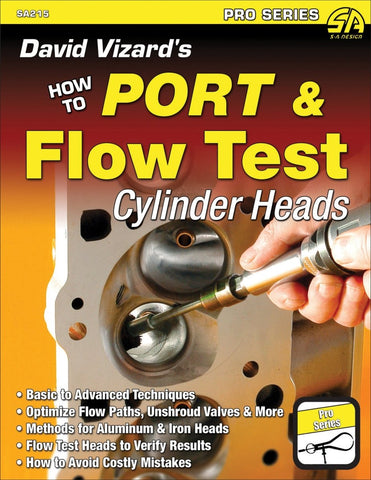About the Author
Acknowledgments
Introduction
Chapter 1: What It Takes to Make Power
Point of Maximum Flow
Seat and Port Priorities
Do You Need a Flow Bench?
Chapter 2: Flow Testing Procedures
The Standard Pressure Drop
Real-World Test Pressures
Corrections
Floating Pressure-Drop Testing
Intake Fixation?
Flow Efficiency
Chapter 3: A Flow Bench—Build or Buy
A Rethink on Matters
Current Conclusions
Flowing the Exhaust
Establishing the Numbers
Summary
Budget Computerization
Audie Technology
Performance Trends
Other Bench Sources
Chapter 4: Wet-Flow Testing
Wet-Flow Testing—What’s it Worth?
Six Wet-Flow Mistakes to Avoid
Chapter 5: Porting Aftermarket Heads
Air Flow Research
Dart
Edelbrock
EngineQuest
Racing Head Service
Trick Flow Specialties
Chapter 6: Porting Tools, Consumables and Safety
Eye and Lung Safety
Grinders—Air or Electric
Carbide Cutters
Support Porting Tools
Sourcing Consumable Supplies
Chapter 7: Five Golden Porting Rules
Rule Number 1
Rule Number 2
Rule Number 3
Rule Number 4
Rule Number 5
Chapter 8: Developing Functional Ports
Valve Seat Forms
Working Valve Seat Shapes
Alternative Seat Angles
Seats on Valves
Valve Shapes
Clearances and Temperatures
Cutting Valve Seats
Chapter 9: Valve Shrouding
Practical De-shrouding
Chapter 10: Developing Functional Heads
Optimizing Cylinder Head Airflow
Valve and Flow
Ports
Cross-Sectional Area
Port Velocity
Applied Basic Porting
Compression Increase
Modified 170s on the Dyno
The Virtual Flow Bench
Chapter 11: The Combustion Process
Defining Combustion
Combustion Efficiency
British Touring Car Championship Year
Finally: The Chambers
More Combustion Curiosities
Atomization Optimization
Thermal Barriers
Swirl and Quench
More Thermal Management
Small Crevice Volume—Big Consequences
Conclusions
Chapter 12: Maximizing Compression Ratio
Thermodynamics Made Easy
Dynamic Compression
Intake- to Exhaust-Valve Ratios
Containing the Pressure
Source Guide
About the Author
Acknowledgments
Introduction
Chapter 1: What It Takes to Make Power
Point of Maximum Flow
Seat and Port Priorities
Do You Need a Flow Bench?
Chapter 2: Flow Testing Procedures
The Standard Pressure Drop
Real-World Test Pressures
Corrections
Floating Pressure-Drop Testing
Intake Fixation?
Flow Efficiency
Chapter 3: A Flow Bench—Build or Buy
A Rethink on Matters
Current Conclusions
Flowing the Exhaust
Establishing the Numbers
Summary
Budget Computerization
Audie Technology
Performance Trends
Other Bench Sources
Chapter 4: Wet-Flow Testing
Wet-Flow Testing—What’s it Worth?
Six Wet-Flow Mistakes to Avoid
Chapter 5: Porting Aftermarket Heads
Air Flow Research
Dart
Edelbrock
EngineQuest
Racing Head Service
Trick Flow Specialties
Chapter 6: Porting Tools, Consumables and Safety
Eye and Lung Safety
Grinders—Air or Electric
Carbide Cutters
Support Porting Tools
Sourcing Consumable Supplies
Chapter 7: Five Golden Porting Rules
Rule Number 1
Rule Number 2
Rule Number 3
Rule Number 4
Rule Number 5
Chapter 8: Developing Functional Ports
Valve Seat Forms
Working Valve Seat Shapes
Alternative Seat Angles
Seats on Valves
Valve Shapes
Clearances and Temperatures
Cutting Valve Seats
Chapter 9: Valve Shrouding
Practical De-shrouding
Chapter 10: Developing Functional Heads
Optimizing Cylinder Head Airflow
Valve and Flow
Ports
Cross-Sectional Area
Port Velocity
Applied Basic Porting
Compression Increase
Modified 170s on the Dyno
The Virtual Flow Bench
Chapter 11: The Combustion Process
Defining Combustion
Combustion Efficiency
British Touring Car Championship Year
Finally: The Chambers
More Combustion Curiosities
Atomization Optimization
Thermal Barriers
Swirl and Quench
More Thermal Management
Small Crevice Volume—Big Consequences
Conclusions
Chapter 12: Maximizing Compression Ratio
Thermodynamics Made Easy
Dynamic Compression
Intake- to Exhaust-Valve Ratios
Containing the Pressure
Source Guide










